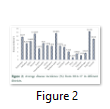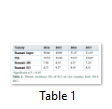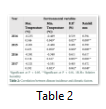Full Length Research Article
Comparative analysis of leaf spot disease in Rice Belt of Punjab, Pakistan
Farman Ahmad Choudhury1,2*, Nasira Jabeen3, Muahammad Saleem Haider1, Riaz Hussain4
Adv. life sci., vol. 6, no. 2, pp. 76-80, February 2019
*- Corresponding Author: Farman Ahmad Choudhury (Email: farmanahmad@hotmail.com)
Authors' Affiliations
2- School of Food and Nutrition, Minhaj University Lahore, Pakistan
3- Institute of Administrative Sciences, University of the Punjab, Pakistan
4- Pest Warning & Quality Control of Pesticides Punjab, Pakistan
Abstract![]()
Introduction
Methods
Results
Discussion
References
Abstract
Background: Brown leaf spot (BLS) caused by Bipolaris oryzae (Breda de Haan) Shoemaker, is a chronic disease of rice that infects millions of hectares worldwide each year. In this study, a total of 18 rice growing districts of Punjab, Pakistan were surveyed during cropping season in 2014-17 for the incidence of BLS disease.
Methods: The survey method was used to gather the data of BLS incidence during 2014-2017 in 18 districts of rice growing areas of Punjab, Pakistan. Meteorological data was collected from the weather stations of each surveyed district and co-related with BLS incidence.
Results: The findings of the study revealed that quantitative relationship exists between meteorological variables and BLS incidence. The incidence of disease in the field was at peak during the month of October. The disease incidence varied from 1.12% to 14.37% over a period of study i.e. from 2014-2017. However, the role of relative humidity (RH) was highly positively correlated with the incidence of disease. Relative humidity showed a positive correlation with the incidence of disease as indicated by the year in which it was towards the high values. The highest disease incidence was observed in district Sargodha whereas the minimum in district Okara. The highest incidence of BLS disease was found in variety Basmati Super (51.43%) and the minimum in Basmati 386 (6.57%).
Conclusion: Our study revealed that the fluctuations in temperature did not depict an appreciable impact on the incidence of BLS as indicated by the statistical coefficient, whereas RH strongly influenced the incidence of BLS incidence.
Keywords: Fungal pathogen, Incidence, Meteorological variables, Rice belt, Relative humidity
Agriculture sector has become the backbone of the Pakistan’s economy by contributing about 24% to the country’s gross domestic product. It feeds almost 45% of the country’s population. Almost 63% of country's population resides in the country side and is directly or indirectly linked with agriculture for its source of revenue [1]. Rice (Oryza sativa L.) is the staple food crop of more than half of the world’s population mainly living in Asia and Africa [2]. Pakistan is among the leading exporters of rice globally by sharing 2 million tons, approximately accounting for the 10% of world trade. Among total rice exported, Basmati rice is known for his unique aroma and has a share of 25% in total rice exports of Pakistan [3].
Pest and diseases pose a continuous threat to rice production. The disease is more generally reported in countries across South and South-East Asia. The disease is responsible for the historic Bengal famine in 1842-43, with reported yield loss of 50- 90%, that lead to the death of nearly 2 million people due to starvation [4].
Brown spot disease is caused by necrotrophic rice leaf fungus Cochliobolus miyabeanus (Ito & Kuribayashi) Drechsler ex Dastur, also called Bipolaris oryzae (Breda de Haan) Shoemaker [5]. The pathogen is one of the devastating and prevalent in rice growing areas [6,7]. The symptoms of disease occur from seedling to milk stage and appear as small spots on the leaf blade, leaf sheath, coleoptile and glumes. On leaves, leaf sheath and coleoptiles, the spots are oval or cylindrical, brown with whitish or grey center and yellow halo. Under severe conditions, spots give a velvety appearance by the production of dark brown conidia and conidiophores. Severe grain infection has been reported to prevent germination, seed rotting and pre-emergence damping off. The diseased plants are stunted and the diseased field appeared as burnt or scorched [8]. The yield reduction can be as high as 45% in severe infection and 12% in moderate infection [9].
The primary infection of the disease is seed-borne while secondary infection occurs from wind-borne inoculum. Soil, infested debris and weed hosts are the inoculum reservoirs. The optimum conditions for disease development are 25-30°C for conidial germination and 27-30°C for hyphal growth with RH of over 90%. The rapid spread and occurrence of the disease is favored by continuous rains and cloudy weather with higher day temperature i.e. 25-30°C [10]. For infection to occur the leaf must be wet for 8-24 hours. The disease is favored by temperature stress, water scarcity and nutrient imbalance [10]. Moreover, the disease also comes in epidemic form where soils have poor nutritional profile and low pH [11].
Keeping in view the above stated yield losses caused by the pathogen and disease etiology regarding rice production; the study was planned to calculate disease incidence of BLS in relationship with meteorological factors for rice protection. The study will help the government agencies and agriculturists to direct future efforts in planning strategies to overcome the threat and disseminate necessary information to the rice farming community of Punjab.
Survey and disease assessment
The study adopted the quantitative methodology using the survey method to derive its findings. A comprehensive survey was conducted during 2014-2017 in the major rice growing areas of Punjab, Pakistan (Figure 1) as defined by the Directorate General, Pest Warning and Quality Control of Pesticides, Agriculture Department, Government of Punjab, Pakistan. Total eighteen districts were regularly scouted for the brown leaf spot disease (Figure 1).
The scouting was carried out by moving diagonally or in zigzag manner in a field, starting from ten meter inside the field [12]. The disease incidence was recorded by thoroughly examining at ten points in a field. Each site was selected five paces apart. Disease incidence percentage was calculated using the following formula;
Disease Incidence (%) = No. of brown spot infected plants x 100
Total No. of plants examined
The severity of the diseases was recorded by grading the scale (0-3 scale of Standard Evaluation). The following grades were used for disease of brown spots:
0 = No incidence,
1 = Less than 25%,
2 = Less than 50%
3 = >50% lesion area.
Meteorological data
Meteorological data was collected from the weather stations of each surveyed districts during the rice season in the years 2014 to 2017. The maximum and minimum temperature, RH indices and rain fall were recorded. Month wise means were calculated and correlated with disease incidence.
Statistical analysis
Analysis of variance (ANOVA) was performed to analyze the significant difference in disease incidence percentage recorded in each of the 18 districts. Pearson's correlation was applied at P≤ 0.05 to find the relationships between meteorological variables and the incidence of brown leaf spots using the Statistical Package for Social Sciences (SPSS® version 16.020).
Disease Assessment
BLS disease was predominantly observed on rice during the four growth seasons i.e. from 2014 to 2017. The findings of the study reflected that mean disease incidence varied from 1.127 in Okara to 14.37 in Sargodha (Figure 2) during the research period. The average incidence of BLS disease ranged from 6.50 to 8.75 for the period of study from 2014-2017 (Figure 4). There were seemingly no significant differences between incidences of disease in different years.
As shown in the figures 2 and 3 variability of the incidence of BLS remained from 1.127 to 14.37% on an average basis during 2014-2017.The severity of the disease varied significantly for each variety (Table 1). Among different varieties of rice planted in the field, the highest severity of brown spot was found in Basmati Super Rice (51.47%) followed by PS-2 (33.53%), Basmati 515 (9.37%) and the minimum in Basmati 386 (6.57%).
Correlation of environmental variables with disease incidence
The data showed that the maximum temperature, RH and rainfall had significant effect on the development of disease in the field while the maximum temperature did not affect disease incidence. The current study has found the association between the incidence of BLS and the meteorological factors including temperature, RH indices and rainfall (Table 2). The results suggested that rainfall and humidity had the highest impact on BLS occurrence. The results showed that the maximum temperature did not show any correlations with BLS disease incidence during 2014-17, with correlation coefficients of −0.235, -0.201, -0.381 and -0.321, respectively. The minimum temperature on the other hand, showed significant negative relationship with disease incidence, with correlation coefficients of-0.469, -0.468, -0.340 and -0.5318 for years 2014 to 2017, respectively. Relative humidity showed a positively correlation disease incidence with a factor load of 0.519, 0.469, 0.611 and 0.483 for years 2014 to 2017, respectively. Rainfall exerted strongest influence on disease incidence and thereby was the major contributing factor towards BLS.
Tables & Figures
Rice is staple food of about two billion people worldwide [14]. It is estimated that rice crop is threatened by almost 50 diseases including 21 fungal, 6 bacterial, 12 viral, 4 nematodes and 7 others diseases and disorders [5,15]. Rice together with wheat (Triticum aestivum L.) is as important as gold to the world’s economy and enjoys a unique position among cash crops of Pakistan. Rice infestation with pests and disease are among the major causes deteriorating the rice yield. Rice diseases solely account for 5% yield losses [16].
Bipolaris oryzae conidia are multicellular, usually germinate bipolarly at maturity and generate more than one infection points [6]. There are several factors responsible for the occurrence of the disease in the field. Essentially, all the components interactively influence the disease and relate to each other in a disease pyramid. Rice production and disease development are influenced by climatic conditions. In accordance to our findings, a study also reported the positive correlation of BLS occurrence with the RH [17]. Earlier, Pal and co-workers also correlated the weather parameters with Sheath blight disease in rice [18]. Additionally, it was found that the temperature did not influence the incidence of BLS. The possible explanation is that rise and fall in the mercury column (maximum & minimum temperature) did not differ in the specific months of the years over many decades in Pakistan. Whereas the precipitation and RH are the major variants in the climatic zone as this region lies in the Northern hemisphere of the globe has long been experiencing dry and wet years for several decades.
The disease is prevalent in all the rice growing areas of the world and holds an important position among fungal pathogens of rice crop. The BLS disease incidence was associated with favourable meteorological conditions for the successful infection including undesirably heavy dew periods and moderate temperature [13]. In addition to that nutritional deficiency has also been associated with BLS has been also associated with plant nutrition and soil fertility [19]. The yield losses caused by the brown spot BLS, are in the range of approximately 10 % of the attainable yield [20,21] in tropical and subtropical Asia. Moreover, alterations in the rainfall pattern also add to the increased incidence of BLS [21]. Environmental factors such as temperature and RH interfere with the infection capability of the pathogen [22].
It is concluded that quantitative relationship exists between meteorological variables and BLS incidence. The rise (Maximum) and fall (Minimum) in temperature did not show an appreciable impact on the incidence of BLS. RH showed a strong positive correlation with the incidence of disease. It is suggested that, for an effective BLS control, more consideration should be given to meteorological variables in future.
Acknowledgment
Authors are thankful to the Institute of Agricultural Sciences, University of the Punjab Lahore and Pest warning and quality control of pesticides for providing the facilities to conduct the study.
The authors declare that there is no conflict of interest regarding the publication of this paper.
- Economics Survey, Ministry of Finance and Economic Affairs, Government of Pakistan, Islamabad Pakistan. 2015-16; www.finance.gov.pk.
- Matsumura KI, Hijmans RJ, CY Elvidge, Sugimoto KWW, Lee YW et al. Mapping the global supply and demand structure of rice. Sustainability Science, (2009); 4(2): 301-313.
- Anonymous, Economic Survey of Pakistan. Govt. Pak., Fin. Div. Adv. Wing, Islamabad.
- Agrios, G. N. Introduction to plant pathology: (2005); 5th edition: Elsevier Academic Press Publication.
- Webster RK, Gunnell PS. Compendium of Rice Diseases. (1992); 040. 064. The American Phytopathological Society (APS), St Paul, MN, USA.
- Ou SH. Rice disease. 1985; 2nd ed: pp- 380. Commonwealth Mycological Institute.
- Ahn IP, Kim S, Kang S, Suh SC, Lee YH. Rice defense mechanisms against Cochliobolus miyabeanus and Magnaporthe grisea are distinct. Phytopathology, (2005); 95(11): 1248-1255.
- Harish S, Saravanakumar D, Radjacommare R, Ebenezar EG, Seetharaman K. Use of plant extracts and biocontrol agents for the management of brown spot disease in rice. BioControl, (2008); 53(3): 555.
- IRRI: International Rice Research Institute, Standard Evaluation System for Rice, (1996); International Rice Testing Program PO Box 933, Manila, Philippines.
- Percich JA, Nyvall RF, Malvick DK, Kohls CL. Interaction of temperature and moisture on infection of wild rice by Bipolaris oryzae in the growth chamber. Plant Disease, (1997); 81: 1193–1195.
- Carvalho MP, Rodrigues FA, Silveira PR, Andrade CCL, Baroni JCP, et al. Rice resistance to brown spot mediated by nitrogen and potassium. Journal of phytopathology, (2010); 158(3): 160-166.
- Barnwal MK, Kotasthane A, Magculia N, Mukherjee PK, Savary S, et al. A review on crop losses, epidemiology and disease management of rice brown spot to identify research priorities and knowledge gaps. European Journal of Plant Pathology, (2013); 136(3): 443-457.
- Chakrabarti NK. Epidemiology and disease management of brown spot of rice in India. In: Major Fungal Diseases of Rice. (2001); Springer,Dordrecht.
- Pillalyar. 1988. Rice pest Prot. Manu. Wiley Eastern Ltd. New Delhi.
- Jabeen R, Iftikhar T, Batool H. Isolation, characterization, preservation and pathogenicity test of Xanthomonas oryzae PV. oryzae causing BLB disease in rice. Pakistan Journal of Botany, (2012); 44(1): 261-265.
- Song FN, Goodman RM. Molecular biology of disease resistance in rice. Physiological and Molecular Plant Pathology, (2001); 59(1): 1-11.
- Dhaliwal LK, Sandhu SK, Kaur S, Singh S. Effect of meteorological parameters on incidence of brown leaf spot in rice crop under different planting methods. Furrow, (2018); 49(30.5): 75.
- Pal R, Mandal D, Biswas, MK, Panja BN. Effect of weather parameters on initiation and progression of sheath blight of rice. Journal of Agrometeorology, (2017); 19(1): 39-43.
- Singh RK, Singh CV, Shukla VD. Phosphorus nutrition reduces brown spot incidence in rainfed upland rice. International Rice Research Notes, (2005); 30(2): 31–32.
- Savary S, Willocquet L, Elazegui FA, Castilla N, Teng PS. Rice pest constraints in tropical Asia: quantification of yield losses due to rice pests in a range of production situations. Plant Disease, (2000); 84: 357–369.
- Savary S, Castilla, NP, Elazegui, FA, Teng PS. Multiple effects of two drivers of agricultural change, labour shortage and water scarcity, on rice pest profiles in tropical Asia. Field Crops Research, (2005); 91: 263–271.
- Percich JA, Nyvall RF, Malvick DK, Kohls CL. Interaction of temperature and moisture on infection of wild rice by Bipolarisoryzae in the growth chamber. Plant disease, (1997); 81(10): 1193-1195.
This work is licensed under a Creative Commons Attribution-Non Commercial 4.0 International License. To read the copy of this license please visit: https://creativecommons.org/licenses/by-nc/4.0









